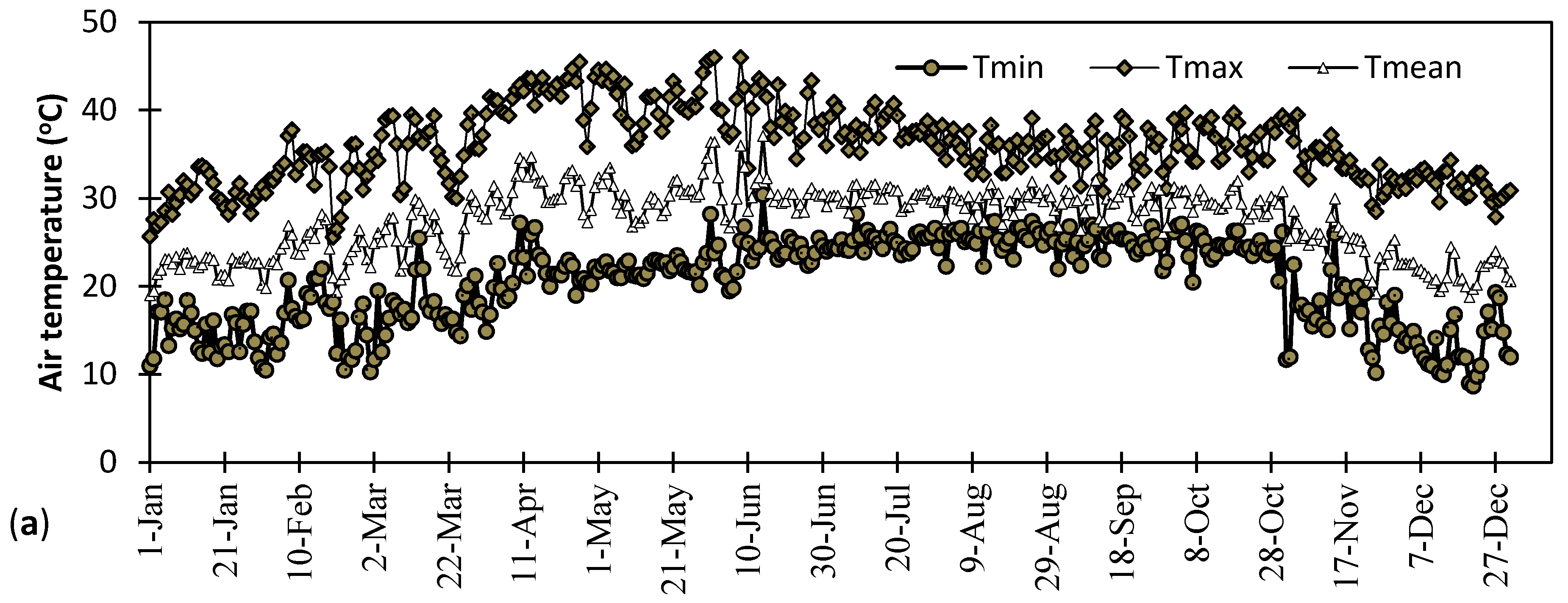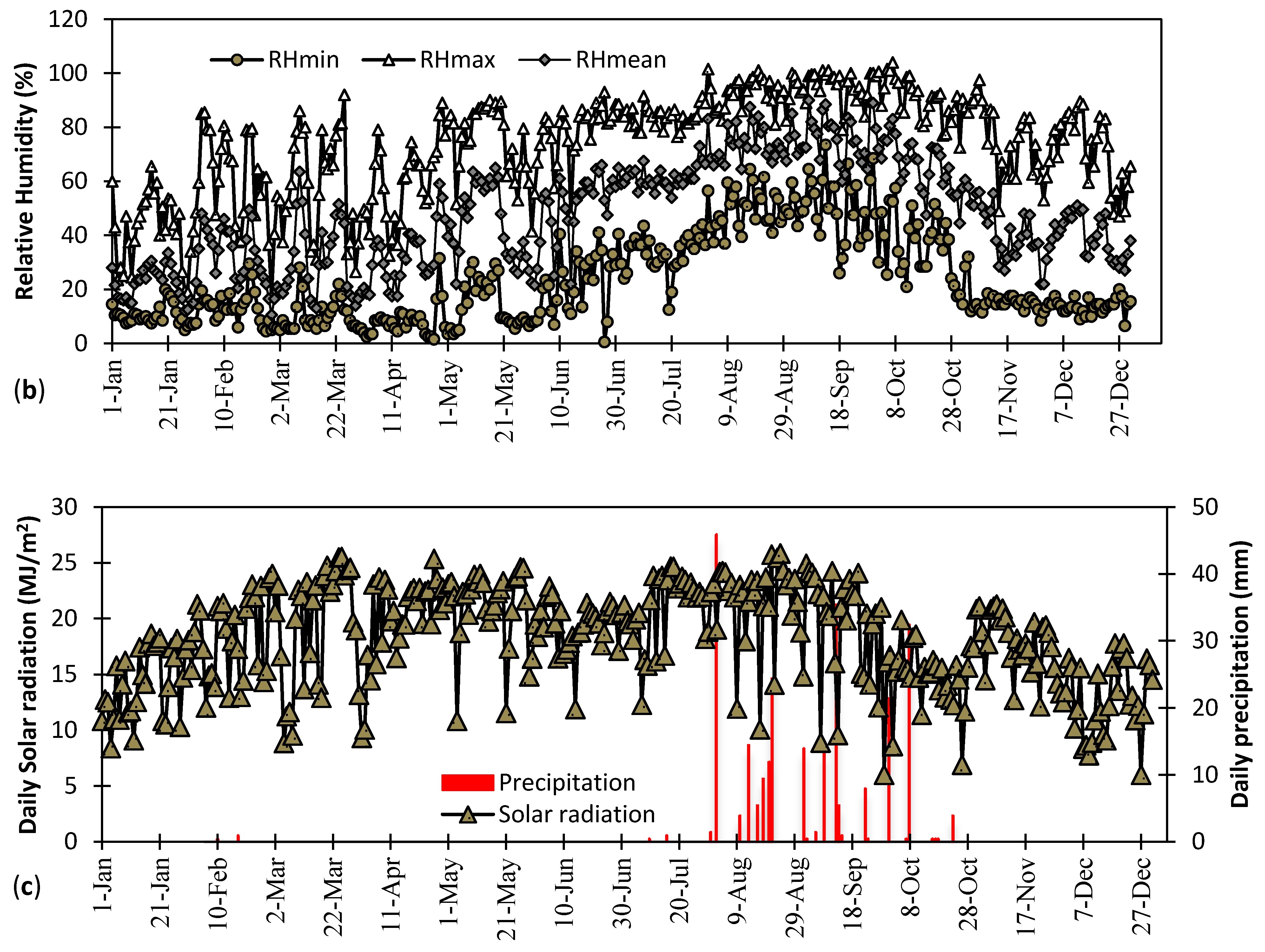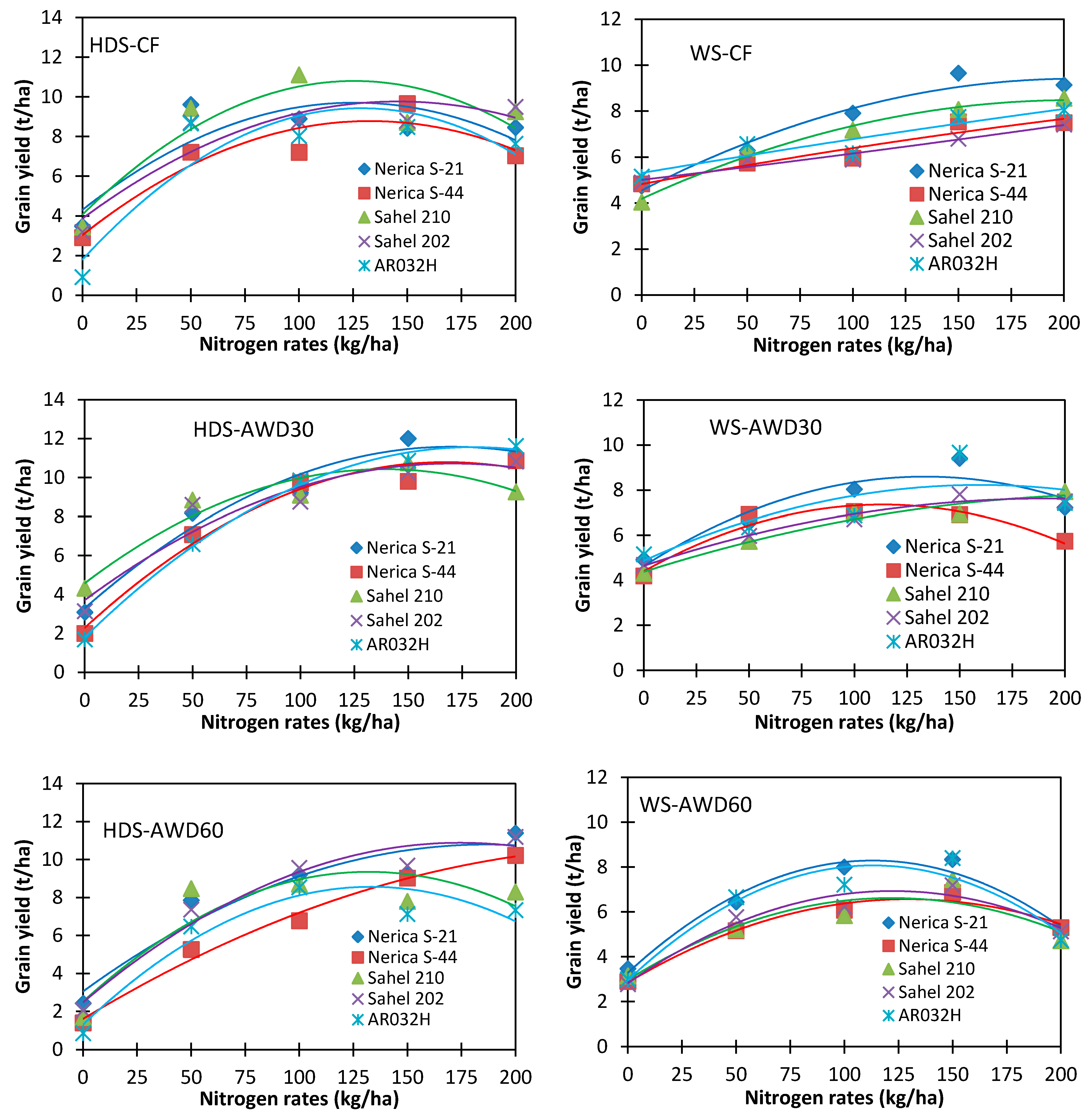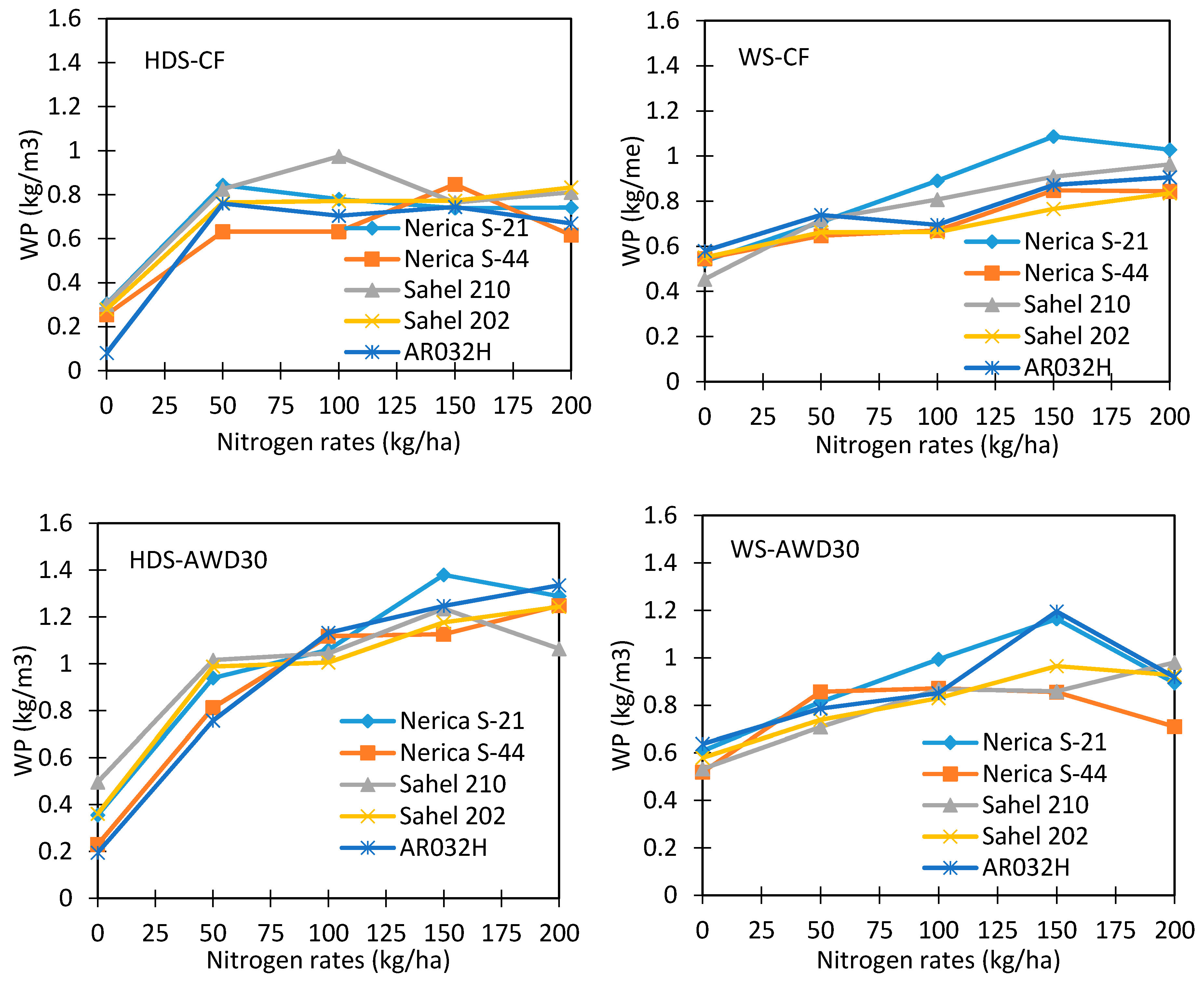Effects of Alternate Wetting and Drying Irrigation Regime and Nitrogen Fertilizer on Yield and Nitrogen Use Efficiency of Irrigated Rice in the Sahel
Abstract
:1. Introduction
2. Materials and Methods
2.1. Site Description
2.2. Experimental Design and Crop Management
2.3. Rice Accumulated Thermal Unit
2.4. Estimation of Nitrogen Use Efficiency (NUE) and Partial Factor Productivity of Nitrogen (PFPN)
2.5. Water Productivity (WP)
2.6. Statistical Analysis
3. Results and Discussion
3.1. Grain Yield and Optimum Nitrogen Fertilizer Rate
3.2. Agronomic Nitrogen Use Efficiency (NUE)
3.3. Partial Factor Productivity of Nitrogen (PFPN)
3.4. Water Productivity (WP)
4. Conclusions
Author Contributions
Acknowledgments
Conflicts of Interest
References
- Djaman, K.; Balde, A.B.; Sow, A.; Muller, B.; Irmak, S.; N’Diaye, M.K.; Manneh, B.; Moukoumbi, Y.D.; Futakuch, K.; Saito, K. Evaluation of sixteen reference evapotranspiration methods under Sahelian conditions in the Senegal River Valley. J. Hydrol. Reg. Stud. 2015, 3, 139–159. [Google Scholar] [CrossRef]
- Mbodj, S. Une Meilleure valorisation des ressources: Des bas-fonds du Sine Saloum par la gire; Expérience du programme de lutte contre la pauvreté en milieu rural dans le Bassin Arachidier. Programme sénégalo-allemand d’appui: Dakar, Senegal, 2008; p. 88. (In French) [Google Scholar]
- De Vries, M.E.; Rodenburg, J.; Bado, B.V.; Sow, A.; Leffelaar, P.A.; Giller, K.E. Rice production with less irrigation water is possible in a Sahelian environment. Field Crops Res. 2010, 116, 154–164. [Google Scholar] [CrossRef]
- Traoré, K.; Bado, B.V.; Guèye, T.; Gaye, S. Grain yield performance of interspecific irrigated rice genotypes in the senegal river valley, as affected by the cropping seasons. West Afr. J. Appl. Ecol. 2010, 17, 65–80. [Google Scholar]
- Van Oort, P.A.J.; de Vries, M.E.; Yoshida, H.; Saito, K. Improved climate risk simulations for rice in arid environments. PLoS ONE 2015, 10, e0118114. [Google Scholar] [CrossRef] [PubMed]
- Tanaka, A.; Diagne, M.; Kazuki, S. Causes of yield stagnation in irrigated lowland rice systems in the Senegal River Valley: Application of dichotomous decision tree analysis. Field Crop Res. 2015, 176, 99–107. [Google Scholar] [CrossRef]
- Djaman, K.; Balde, A.B.; Rudnick, D.R.; Ndiaye, O.; Irmak, S. Long-term trend analysis in climate variables and agricultural adaptation strategies to climate change in the Senegal River Basin. Int. J. Climatol. 2017, 37, 2873–2888. [Google Scholar] [CrossRef]
- García-Bolaños, M.; Borgia, C.; Poblador, N.; Dia, M.; Seyid, O.M.V.; Mateos, L. Performance assessment of small irrigation schemes along the Mauritanian banks of the Senegal River. Agric. Water Manag. 2011, 8, 1141–1152. [Google Scholar] [CrossRef]
- Comas, J.; Connor, D.; El Moctar Isselmou, M.; Mateos, L.; Gómez-Macpherson, H. Why has small-scale irrigation not responded to expectations with traditional subsistence farmers along the Senegal River in Mauritania? Agric. Syst. 2012, 110, 152–161. [Google Scholar] [CrossRef]
- Djaman, K.; Mel, V.C.; Balde, A.B.; Bado, B.V.; Diop, L.; Manneh, B.; Mutiibwa, D.; Rudnick, D.; Irmak, S.; Futakuchi, K. Evapotranspiration, irrigation water requirement and water productivity of rice (Oryza sativa L.) in the Sahelian environment. Paddy Water Environ. 2017, 15, 469–482. [Google Scholar] [CrossRef]
- Raes, D.; Sy, B.; Feyen, J. Water use in rice schemes in the Senegal River Delta and Valley. Irrig. Drain. Syst. 1995, 9, 117–128. [Google Scholar] [CrossRef]
- Saito, K.; Nelson, A.; Zwart, S.J.; Niang, A.; Sow, A.; Yoshida, H.; Wopereis, M.C.S. Towards a better understanding of biophysical determinants of yield gaps and the potential for expansion of the rice area in Africa. In Realizing Africa’s Rice Promise; Wopereis, M.C.S., Johnson, D.E., Ahmadi, N., Tollens, E., Jalloh, A., Eds.; CABI: Wallingford, UK, 2013; pp. 188–203. [Google Scholar]
- OMVS-SOGREAH. Etude Complémentaire des Endiguements du Fleuve Senegal Premiere Phase Rapport D’inventaire-Diagnostrc; OMVS: Dakar, Senegal, 1998. [Google Scholar]
- Tuong, T.P.; Bhuiyan, S.I. Increasing water-use efficiency in rice production: Farm-level perspectives. Agric. Water Manag. 1999, 40, 117–122. [Google Scholar] [CrossRef]
- Li, C.; Salas, W.; DeAngelo, B.; Rose, S. Assessing alternatives for mitigating net greenhouse gas emissions and increasing yields from rice production in China over the next twenty years. J. Environ. Qual. 2006, 35, 1554–1565. [Google Scholar] [CrossRef] [PubMed]
- Belder, P.; Bouman, B.A.M.; Spiertz, J.H.J.; Cabangon, R.; Guoan, L.; Quilang, E.J.P.; Li, Y.; Tuong, T.P. Effect of water and nitrogen management on water use and yield of irrigated rice. Agric. Water Manag. 2004, 65, 193–210. [Google Scholar] [CrossRef]
- Moya, P.; Hong, L.; Dawe, D.; Chongde, C. The impact of on-farm water saving irrigation techniques on rice productivity and profitability in Zhanghe irrigation system, Hubei, China. Paddy Water Environ. 2004, 2, 207–215. [Google Scholar] [CrossRef]
- Zhang, Y.; Tang, Q.; Peng, S.; Xing, D.; Qin, J.; Laza, R.C.; Punzalan, B.R. Water use efficiency and physiological response of rice cultivars under alternate wetting and drying conditions. Sci. World J. 2012, 2012, 287907. [Google Scholar] [CrossRef] [PubMed]
- Tan, X.; Shao, D.; Liu, H.; Yang, F.; Xiao, C.; Yang, H. Effects of alternate wetting and drying irrigation on percolation and nitrogen leaching in paddy fields. Paddy Water Environ. 2013, 11, 381–395. [Google Scholar] [CrossRef]
- Rejesus, R.; Palis, F.; Rodriguez, D.G.P.; Lampayan, R.M.; Bouman, A.A.M. Impact of the Alternate Wetting and Drying (AWD) Water-saving Irrigation Technique: Evidence from Rice Producers in the Philippines. Food Policy 2011, 36, 280–288. [Google Scholar] [CrossRef]
- Lampayan, R.M.; Roderick, M.R.; Singletona, R.; Bouman, A.M. Adoption and Economics of Alternate Wetting and Drying Water Management for Irrigated Lowland Rice. Field Crops Res. 2015, 170, 95–108. [Google Scholar] [CrossRef]
- Yang, J.-C.; Zhang, J.-H. Grain-filling problem in ‘super’ rice. J. Exp. Bot. 2010, 61, 1–5. [Google Scholar] [CrossRef] [PubMed]
- Zhao, L.-M.; Wu, L.-H.; Li, Y.-S.; Lu, X.-H.; Zhu, D.-F.; Uphoff, N. Influence of the system of rice intensification on rice yield and nitrogen and water use efficiency with different N application rates. Exp. Agric. 2009, 45, 275–286. [Google Scholar] [CrossRef]
- LaHue, G.T.; Rufus, L.C.; Adviento-Borbe, A.M.; Linquist, B.A. Alternate wetting and drying in high yielding direct-seeded rice systems accomplishes multiple environmental and agronomic objectives. Agric. Ecosyst. Environ. 2016, 229, 30–39. [Google Scholar] [CrossRef]
- Li, Y.; Barker, R. Increasing water productivity for paddy irrigation in China. Paddy Water Environ. 2004, 2, 187–193. [Google Scholar] [CrossRef]
- Humphreys, E.; Li, T.; Gill, G.; Kukal, S.S. Evaluation of tradeoffs in land and water productivity of dry seeded rice as affected by irrigation schedule. Field Crops Res. 2012, 128, 180–190. [Google Scholar]
- Xue, L.-H.; Li, G.-H.; Qin, X.; Yang, L.-Z.; Zhang, H.-L. Topdressing nitrogen recommendation for early rice with an active sensor in south China. Precis. Agric. 2014, 15, 95–110. [Google Scholar] [CrossRef]
- Howell, K.; Shrestha, R.; Pitambar, D.; Ian, C. Alternate wetting and drying irrigation maintained rice yields despite half the irrigation volume, but is currently unlikely to be adopted by smallholder lowland rice farmers in Nepal. Food Energy Secur. 2015, 4, 144–157. [Google Scholar] [CrossRef] [PubMed] [Green Version]
- Richards, M.; Sander, B.O. Alternate Wetting and Drying in Irrigated Rice; Climate Smart Agriculture Practice Brief; CGIAR Research Program on Climate Change, Agriculture and Food Security (CCAFS): Copenhagen, Denmark, 2014. [Google Scholar]
- Devkota, K.P.; Manschadi, A.M.; Lamers, J.P.A.; Humphreys, E.; Devkota, M.; Egamberdiev, O.; Gupta, R.K.; Sayre, K.D.; Vlek, P.L.G. Growth and yield of rice (Oryza sativa L.) under resource conservation technologies in the irrigated drylands of Central Asia. Field Crops Res. 2013, 149, 115–126. [Google Scholar] [CrossRef]
- Wopereis, M.C.S.; Ceuppens, J.; Boivin, P.; Ndiaye, A.M.; Kane, A. Preserving soil quality under irrigation in the Senegal River Valley. Neth. J. Agric. Sci. 1998, 46, 97–107. [Google Scholar]
- Poussin, J.C.; Diallo, Y.; Legoupil, J.C.; Sow, A. Increase in rice productivity in the Senegal River Valley due to improved collective management of irrigation schemes. Agron. Sustain. Dev. 2005, 25, 225–236. [Google Scholar] [CrossRef]
- Krupnik, T.J.; Shennan, C.; Settle, W.H.; Demont, M.; Ndiaye, A.B.; Rodenburg, J. Improving irrigated rice production in the Senegal River Valley through experiential learning and innovation. Agric. Syst. 2012, 109, 101–112. [Google Scholar] [CrossRef]
- Yoshida, H.; Horie, T.; Shiraiwa, T. A model explaining genotypic and environmental variation of rice spikelet number per unit area measured by cross-locational experiments in Asia. Field Crops Res 2006, 97, 337–343. [Google Scholar] [CrossRef]
- Harrel, D.L.; Bond, J.A.; Blanche, S. Evaluation of main-crop stubble height on ratoon rice growth and development. Field Crops Res. 2009, 114, 396–403. [Google Scholar] [CrossRef]
- Saito, K.; Diack, S.; Dieng, I.; Ndiaye, M.K. On-farm testing of a nutrient management decision-support tool for rice in the Senegal River valley. Comput. Electron. Agric. 2015, 116, 36–44. [Google Scholar] [CrossRef]
- Harrell, D.L.; Tubaña, B.S.; Lofton, J.; Kanke, Y. Rice response to nitrogen fertilization under stale seedbed and conventional tillage systems. Agron. J. 2011, 103, 494–500. [Google Scholar] [CrossRef]
- Peng, S.; Cassman, K.G.; Virmani, S.S.; Sheehy, J.; Khush, G.S. Yield potential trends of tropical rice since the release of IR8 and the challenge of increasing rice yield potential. Crop Sci. 1999, 39, 1552–1559. [Google Scholar] [CrossRef]
- Djaman, K.; Bado, B.V.; Mel, V.C. Effect of nitrogen fertilizer on yield and nitrogen use efficiency of four aromatic rice varieties. Emir. J. Food Agric. 2016, 28, 126–135. [Google Scholar]
- Fan, M.; Shen, J.; Yuan, L.; Jiang, R.; Chen, X.; Davies, W.J. Improving crop productivity and resource use efficiency to ensure food security and environmental quality in China. J. Exp. Bot. 2012, 63, 13–24. [Google Scholar] [CrossRef] [PubMed]
- Dobermann, A.; Cassman, K.G.; Peng, S.; Pham, S.T.; Cao, V.P.; Sta Cruz, P.C.; Bajita, J.B.; Adviento, M.A.A.; Olk, D.C. Precision nutrient management in intensive irrigated rice systems. In Proceedings of the International Symposium on Maximizing Sustainable Rice Yields through Improved Soil and Environmental Management, Khon Kaen, Thailand, 11–17 November 1996; pp. 38–52. [Google Scholar]
- Wang, E.; Wang, J.; Zhu, X. Control of rice grain-filling and yield by a gene with a potential signature of domestication. Nat. Genet. 2008, 40, 1370–1374. [Google Scholar] [CrossRef] [PubMed]
- Cassman, K.G.; Dobermann, A.; Walters, D.T.; Yang, H. Meeting cereal demand while protecting natural resources and improving environmental quality. Ann. Rev. Energy Environ. 2003, 28, 315–358. [Google Scholar]
- Diagne, M.; Demont, M.; Seck, P.A.; Diaw, A. Self-sufficiency Policy and Irrigated Rice Productivity in the Senegal River Valley. Food Secur. 2013, 5, 55–68. [Google Scholar] [CrossRef]
- Diène, S. Riziculture et Dégradation des Sols en Vallée du Fleuve Sénégal: Analyse Comparée des Fonctionnements Hydro-Salins des Sols du Delta et de la Moyenne Vallée en Simple et Double Riziculture. Ph.D. Thesis, University of Dakar, Dakar, Senegal, 1998. [Google Scholar]
- Haefele, S.M.; Wopereis, M.C.S.; Donovan, C.; Maubuisson, J. Improving the productivity and profitability of irrigated rice production in Mauritania. Eur. J. Agron. 2001, 14, 181–196. [Google Scholar] [CrossRef]
- Cassman, K.G.; Gines, G.C.; Dizon, M.A.; Samson, M.I.; Alcantara, J.M. Nitrogen-use efficiency in tropical lowland rice systems: Contributions from indigenous and applied nitrogen. Field Crops Res. 1996, 47, 1–12. [Google Scholar] [CrossRef]
- Nielsen, R. N Loss Mechanisms and Nitrogen Use Efficiency. Perdue Nitrogen Management Workshops. 2006. Available online: https://www.agry.purdue.edu/ext/pubs/2006NLossMechanisms.pdf (accessed on 16 June 2017).
- Bos, M.G. Irrigation efficiencies at crop production level. ICID Bull. 1980, 29, 18–25. [Google Scholar]
- Bos, M.G. Summary of ICID definitions of irrigation efficiency. ICID Bull. 1985, 34, 28–31. [Google Scholar]
- Dobermann, A. Nutrient use efficiency–measurement and management. In Proceedings of the IFA International Workshop on Fertilizer Best Management Practices, Brussels, Belgium, 7–9 March 2007; pp. 1–28. [Google Scholar]
- SAS Institute. JMP Statistics and Graphics Guide, version 3.1; SAS Institute: Gary, NC, USA, 1995. [Google Scholar]
- Barker, R.; Loeve, R.; Li, Y.H.; Tuong, T.P. Water-saving irrigation for rice. Proceedings of an International Workshop, Wuhan, China, 23–25 March 2001; International Water Management Institute: Colombo, Sri Lanka, 2001. [Google Scholar]
- Zhang, H.; Xue, Y.; Wang, Z.; Yang, J.; Zhang, J. Alternate wetting and moderate soil drying improves root and shoot growth in rice. Crop Sci. 2009, 49, 2246–2260. [Google Scholar] [CrossRef]
- Matsuo, N.; Mochizuki, T. Genotypic differences in root traits of rice (Oryza sativa L.) seedlings grown under different soil environments. Plant Root 2009, 3, 17–25. [Google Scholar] [CrossRef]
- Bouman, B.A.M.; Tuong, T.P. Field water management to save water and increase its productivity in irrigated lowland rice. Agric. Water Manag. 2001, 49, 11–30. [Google Scholar] [CrossRef]
- Cabangon, R.J.; Castillo, E.G.; Tuong, T.P. Chlorophyll meter-based nitrogen management of rice grown under alternate wetting and drying irrigation. Field Crops Res. 2011, 121, 136–146. [Google Scholar] [CrossRef]
- Bueno, C.S.; Bucourt, M.; Kobayashi, N.; Inubushi, K.; Lafarge, T. Water productivity of contrasting rice genotypes grown under water-saving conditions in the tropics and investigation of morphological traits for adaptation. Agric. Water Manag. 2010, 98, 241–250. [Google Scholar] [CrossRef]
- Liu, L.; Chen, T.; Wang, Z.; Zhang, H.; Yang, J.; Zhang, J. Combination of site-specific nitrogen management and alternate wetting and drying irrigation increases grain yield and nitrogen and water use efficiency in super rice. Field Crops Res. 2013, 154, 226–235. [Google Scholar] [CrossRef]
- Ye, M.; Song, Y.; Long, J.; Wang, R.; Baerson, S.R.; Pan, Z.; Zhu-Salzman, K.; Xie, J.; Cai, K.; Luo, S.; et al. Priming of jasmonate-mediated antiherbivore defense responses in rice by silicon. Proc. Natl. Acad. Sci. USA 2013, 110, E3631–E3639. [Google Scholar] [CrossRef] [PubMed]
- Peng, S.-B.; Buresh, R.J.; Huang, J.-L.; Yang, J.-C.; Zou, Y.-B.; Zhong, X.-Y.; Wang, G.-H.; Zhang, F.-S. Strategies for overcoming low agronomic nitrogen use efficiency in irrigated rice systems in China. Field Crops Res. 2006, 96, 37–47. [Google Scholar] [CrossRef]
- Saichuk, J.K.; Blanche, S.B.; Courville, B.; Harrell, D.L.; Groth, D.E.; Hollier, C.; Hummel, N.; Linscombe, S.D.; Rush, C.; Sha, X.; et al. Rice Varieties and Management Tips 2010; LA Coop. Ext. Pub.2270; Louisiana State University Agricultural Center: Baton Rouge, LA, USA, 2009. [Google Scholar]
- Bado, V.B.; Djaman, K.; Mel, V.C.; Nati, D.A.B.; Balde, A.B.; Manneh, B.; Irmak, S. Agronomic performance of salt-tolerant rice genotypes in salt-affected soil under integrated management options of nitrogen, zinc, and gypsum. In Proceedings of the 2nd Minia International Conference for Agriculture and Irrigation in the Nile Basin Countries, Minia, Egypt, 23–25 March 2015. [Google Scholar]
- Yang, C.; Shi, D.; Wang, D. Comparative effects of salt and alkali stresses on growth, osmotic adjustment and ionic balance of an alkali-resistant halophyte Suaeda glauca (Bge.). Plant Growth Regul. 2008, 56, 179–190. [Google Scholar] [CrossRef]
- Peng, S.; Huang, J.; Sheehy, J.E.; Laza, R.C.; Visperas, R.M.; Zhong, X.; Centeno, G.S.; Khush, G.S.; Cassman, K.G. Rice yields decline with higher night temperature from global warming. Proc. Natl. Acad. Sci. USA 2004, 101, 9971–9975. [Google Scholar] [CrossRef] [PubMed]
- Haefele, S.M.; Knoblauch, C.; Gummert, M.; Konboon, Y.; Koyama, S. Black carbon (biochar) in rice-based systems: Characteristics and opportunities. In Amazon Dark Earths; Wim Soembrok’s vision; Woods, W.I., Teixeira, W.G., Lehmann, J., Steiner, C., Prins, A.W., Rebellatods, L., Eds.; Springer: Amsterdam, The Netherlands, 2008; pp. 445–463. [Google Scholar]
- Stuerz, S.; Sow, A.; Muller, B.; Manneh, B.; Asch, F. Yield components in response to thermal environment and irrigation system in lowland rice in the Sahel. Field Crops Res. 2014, 163, 47–54. [Google Scholar] [CrossRef]
- Djaman, K.; Irmak, S.; Martin, D.L.; Ferguson, R.B.; Bernards, M.L. Plant nutrient uptake and soil nutrient dynamics under full and limited irrigation and rainfed maize production. Agron. J. 2013, 105, 527–538. [Google Scholar] [CrossRef]
- Watkins, K.B.; Hignight, J.A.; Norman, R.J.; Roberts, T.L.; Slaton, N.A.; Wilson, C.E.; Frizzell, D.L. Comparison of economic optimum nitrogen rates for rice in Arkansas. Agron. J. 2009, 102, 1099–1108. [Google Scholar] [CrossRef]
- Cassman, K.G.; Pingali, P.L. Extrapolating Trends from Long-Term Experiments to Farmers’ Fields: The Case of Irrigated Rice Systems in Asia. In Agricultural Sustainability in Economic, Environmental and Statistical Terms; Barnet, V., Payne, R., Steiner, R., Eds.; Wiley: London, UK, 1996; pp. 63–68. [Google Scholar]
- Peng, S.-B.; Huang, J.-L.; Zhong, X.-H. Challenge and opportunity in improving fertilizer-nitrogen use efficiency of irrigated rice in China. Agric. Sci. China 2002, 1, 776–785. [Google Scholar]
- Wang, G.-H.; Dobermann, A.; Witt, C.; Fu, R.-X.; Sun, Q.-Z. A new approach to increase the attainable rice yield in intensive irrigated rice systems of Zhejiang Province, China. J. Zhejiang Univ. Sci. 2001, 2, 196–203. [Google Scholar]
- Yang, X.; Zhang, J.-H.; Ni, W. Characteristics of nitrogen nutrition in hybrid rice. Int. Rice Res. Notes 1999, 1, 5–8. [Google Scholar]
- Sandhu, N.; Subedi, S.R.; Yadaw, R.B.; Chaudhary, B.; Prasai, H.; Iftekharuddaula, K.; Kumar, A. Root Traits Enhancing Rice Grain Yield under Alternate Wetting and Drying Condition. Front. Plant Sci. 2017, 8, 1879. [Google Scholar] [CrossRef] [PubMed]
- Tabbal, D.F.; Bouman, B.A.M.; Bhuiyan, S.I.; Sibayan, E.B.; Sattar, M.A. On-farm strategies for reducing water input in irrigated rice, case studies in the Philippines. Agric. Water Manag. 2002, 56, 93–112. [Google Scholar] [CrossRef]
- Davies, W.; Zhang, J.J.; Yang, J.; Dodd, I.C. (Novel crop science to improve yield and resource use efficiency in water- limited agriculture. J. Agric. Sci. 2011, 149, 123–131. [Google Scholar] [CrossRef]
- Yang, J.; Zhou, Q.; Zhang, J. Moderate wetting and drying increases rice yield and reduces water use, grain arsenic level, and methane emission. Crop J. 2017, 5, 151–158. [Google Scholar] [CrossRef]
- Zhu, H.-H.; Chen, C.; Zhu, Q.-H; Huang, D.-Y. Effects of Soil Acidification and liming on the phytoavailability of cadmium in paddy soils of central subtropical China. Environ. Pollut. 2016, 219, 99–106. [Google Scholar] [CrossRef] [PubMed]
- Peng, J.; Xie, X.; Huang, M.; Zhou, X.; Zhang, R.; Chen, J.; Wu, D.; Xia, B.; Xiong, H.; Xu, F.; et al. Characterizing N uptake and use efficiency in rice as influenced by environments. Plant Prod. Sci. 2016, 19, 96–104. [Google Scholar] [CrossRef]
- Espiritu, A.E.; Javier, E.F. Nitrogen use efficiency of different organic fertilizers applied in paddy rice. Philipp. J. Crop Sci. 2013, 38, 81–82. [Google Scholar]
- Ceesay, M.; Reid, W.S.; Fernandes, E.C.; Uphoff, N.T. The effects of repeated soil wetting and drying on lowland rice yield with system of rice intensification (SRI) methods. Int. J. Agric. Sustain. 2006, 4, 5–14. [Google Scholar]
- Pascual, V.J.; Wang, Y.-M. Impact of water management on rice varieties, yield, and water productivity under the system of rice intensification in southern Taiwan. Water J. 2016, 9, 3. [Google Scholar] [CrossRef]
- Carrijo, D.R.; Lundy, M.E.; Linquist, B.A. Rice yields and water use under alternate wetting and drying irrigation: A meta-analysis. Field Crops Res. 2017, 203, 173–180. [Google Scholar] [CrossRef]











© 2018 by the authors. Licensee MDPI, Basel, Switzerland. This article is an open access article distributed under the terms and conditions of the Creative Commons Attribution (CC BY) license (http://creativecommons.org/licenses/by/4.0/).
Share and Cite
Djaman, K.; Mel, V.C.; Diop, L.; Sow, A.; El-Namaky, R.; Manneh, B.; Saito, K.; Futakuchi, K.; Irmak, S. Effects of Alternate Wetting and Drying Irrigation Regime and Nitrogen Fertilizer on Yield and Nitrogen Use Efficiency of Irrigated Rice in the Sahel. Water 2018, 10, 711. https://doi.org/10.3390/w10060711
Djaman K, Mel VC, Diop L, Sow A, El-Namaky R, Manneh B, Saito K, Futakuchi K, Irmak S. Effects of Alternate Wetting and Drying Irrigation Regime and Nitrogen Fertilizer on Yield and Nitrogen Use Efficiency of Irrigated Rice in the Sahel. Water. 2018; 10(6):711. https://doi.org/10.3390/w10060711
Chicago/Turabian StyleDjaman, Koffi, Valere C. Mel, Lamine Diop, Abdoulaye Sow, Raafat El-Namaky, Baboucarr Manneh, Kazuki Saito, Koichi Futakuchi, and Suat Irmak. 2018. "Effects of Alternate Wetting and Drying Irrigation Regime and Nitrogen Fertilizer on Yield and Nitrogen Use Efficiency of Irrigated Rice in the Sahel" Water 10, no. 6: 711. https://doi.org/10.3390/w10060711





